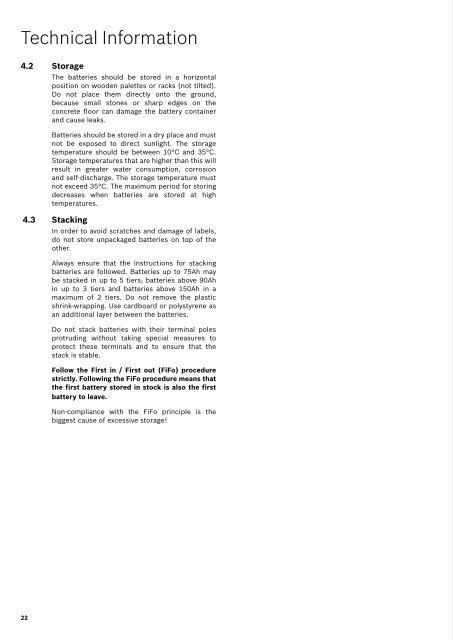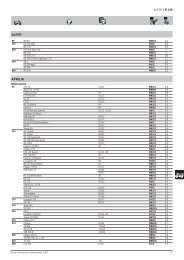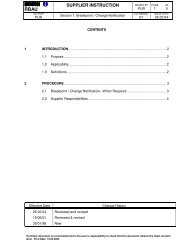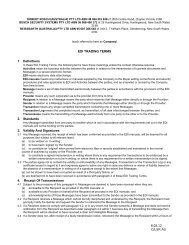For All Vehicles - Bosch Australia
For All Vehicles - Bosch Australia
For All Vehicles - Bosch Australia
Create successful ePaper yourself
Turn your PDF publications into a flip-book with our unique Google optimized e-Paper software.
Technical Information<br />
4.2 Storage<br />
22<br />
The batteries should be stored in a horizontal<br />
position on wooden palettes or racks (not tilted).<br />
Do not place them directly onto the ground,<br />
because small stones or sharp edges on the<br />
concrete floor can damage the battery container<br />
and cause leaks.<br />
Batteries should be stored in a dry place and must<br />
not be exposed to direct sunlight. The storage<br />
temperature should be between 10°C and 35°C.<br />
Storage temperatures that are higher than this will<br />
result in greater water consumption, corrosion<br />
and self-discharge. The storage temperature must<br />
not exceed 35°C. The maximum period for storing<br />
decreases when batteries are stored at high<br />
temperatures.<br />
4.3 Stacking<br />
In order to avoid scratches and damage of labels,<br />
do not store unpackaged batteries on top of the<br />
other.<br />
Always ensure that the instructions for stacking<br />
batteries are followed. Batteries up to 75Ah may<br />
be stacked in up to 5 tiers; batteries above 90Ah<br />
in up to 3 tiers and batteries above 150Ah in a<br />
maximum of 2 tiers. Do not remove the plastic<br />
shrink-wrapping. Use cardboard or polystyrene as<br />
an additional layer between the batteries.<br />
Do not stack batteries with their terminal poles<br />
protruding without taking special measures to<br />
protect these terminals and to ensure that the<br />
stack is stable.<br />
Follow the First in / First out (FiFo) procedure<br />
strictly. Following the FiFo procedure means that<br />
the first battery stored in stock is also the first<br />
battery to leave.<br />
Non-compliance with the FiFo principle is the<br />
biggest cause of excessive storage!<br />
FAQs<br />
1 What is the difference between a cell and a<br />
battery?<br />
The smallest electrochemical unit of a battery is called<br />
a cell. The cell does not have a complete container<br />
or contacts ready for use and is usually connected<br />
to neighbouring battery cells by means of soldered<br />
contacts.<br />
Unlike a cell, it is easy to recognize a battery by its<br />
completed container that is equipped with contacts<br />
that are ready for use. Additionally, the container<br />
bears the manufacturer’s name clearly printed on it,<br />
the name of the type, the battery voltage, etc.<br />
2 How is the battery constructed?<br />
A 12V starter battery contains six individually<br />
separated cells that are connected in series in a<br />
polypropylene container. Each cell contains an element<br />
(cell package) that is made up of a set of positive<br />
and negative plates. In turn, these sets comprise<br />
lead plates (lead grid and active material) and microporous<br />
insulation material (separators) between the<br />
plates with opposite polarities. The electrolyte is<br />
diluted sulphuric acid. It permeates the pores of the<br />
plates and the separators and fills up the voids in the<br />
cells. The terminals, the cell connectors and the plate<br />
connections are all made of lead. A thermal sealing<br />
process is used to permanently bond the battery to<br />
its container, providing a superior quality seal for the<br />
battery.<br />
3 What is the electrolyte?<br />
The electrolyte is diluted sulphuric acid that permeates<br />
the pores of the plates and separators. It fills up the<br />
voids in the cells. The sulphuric acid component is<br />
responsible for turning pure water conductive so that<br />
it can be used as electrolyte.<br />
4 What happens when a battery becomes<br />
discharged?<br />
If a device (for example, a lamp) is connected to the<br />
terminals of a lead-acid battery, the difference in<br />
power between the poles results in a flow of electrons<br />
leaving the negative pole and flowing through the<br />
device and on to the positive pole.<br />
This flow of electrons transforms the lead dioxide on<br />
the positive plate and the spongy lead on the negative<br />
plate into lead sulphate. This chemical process<br />
consumes the sulphuric acid and yields water. The<br />
specific gravity of the electrolyte is thus decreased<br />
and it is because of this that the state of charge of the<br />
battery can be determined, by measuring the specific<br />
gravity of the electrolyte.<br />
5 What happens when a battery is charged?<br />
When a battery is being charged, the flow of electrons<br />
and the chemical processes that occur during<br />
discharge are reversed. The result of the charging<br />
process is that the lead sulphate that is formed during<br />
the discharge process is once again converted into<br />
lead dioxide, lead and sulphuric acid and this restores<br />
the necessary chemical energy that will be converted<br />
into electrical power during future use.<br />
An optimum charge voltage is important for charging<br />
a battery. If the voltage is too high, the water will be<br />
electrolysed. This reduces the electrolyte level over a<br />
period of time. If the voltage is too low, the battery<br />
cannot be adequately charged and this can also<br />
reduce its service life.<br />
6 What are the consequences of a short circuit in the<br />
battery?<br />
An external short circuit can occur if the battery<br />
terminals are connected by any type of conductive<br />
material. Depending on the battery system, a short<br />
circuit can have serious consequences. Lead-acid<br />
batteries are very powerful and a short circuit can<br />
cause burns, fires or an explosion of the battery.<br />
Never connect the positive pole of the battery to its<br />
negative pole. When installing the battery, or when<br />
attaching the connecting cables to the battery poles,<br />
take all necessary measures to avoid short-circuits<br />
caused by tools or other conductive materials.<br />
7 What does the abbreviation OCV mean and what<br />
does it tell me concerning the battery?<br />
OCV stands for Open Circuit Voltage – the voltage<br />
in an open circuit. Other common terms are ‘offload<br />
voltage’ or ‘voltage without load’. As the name<br />
indicates, OCV is the voltage measured between the<br />
two poles of the battery when the battery is not under<br />
load (no current consumption).<br />
The OCV changes on completion of the charging or<br />
discharging process due to the effects of polarization<br />
and diffusion. The battery should be set aside, in<br />
a state of rest, sometimes up to a few days, until it<br />
reaches a stable state. If the OCV is measured shortly<br />
after a charging or discharging process, it will not<br />
be possible to obtain a correct value for the state of<br />
charge.<br />
8 What is meant by battery capacity?<br />
The capacity is the amount of electrical power that<br />
a battery can deliver under specific conditions. It is<br />
the product of the current and the time (ampere-hour,<br />
Ah).<br />
The capacity is not a fixed parameter, but depends,<br />
among other things, on the following factors:<br />
23















